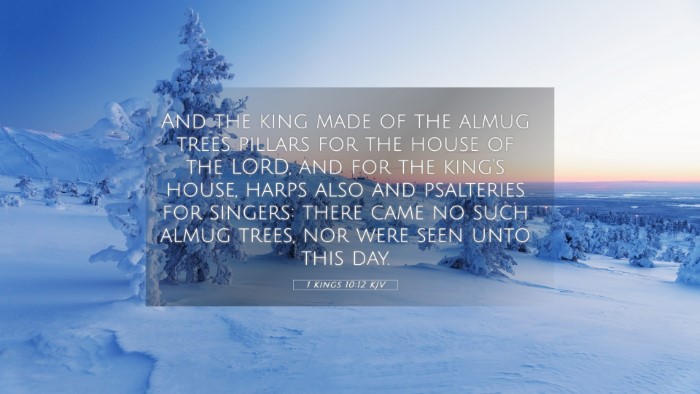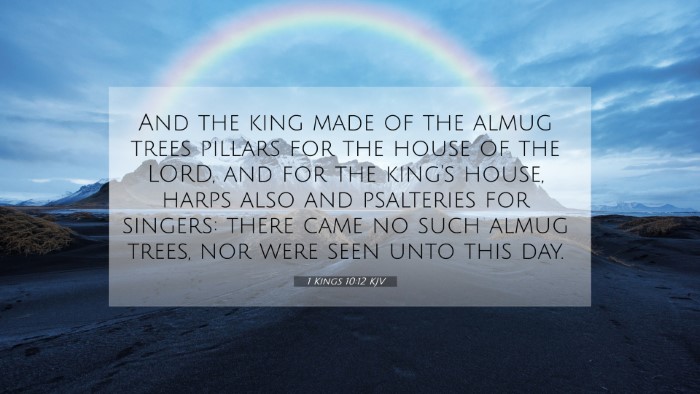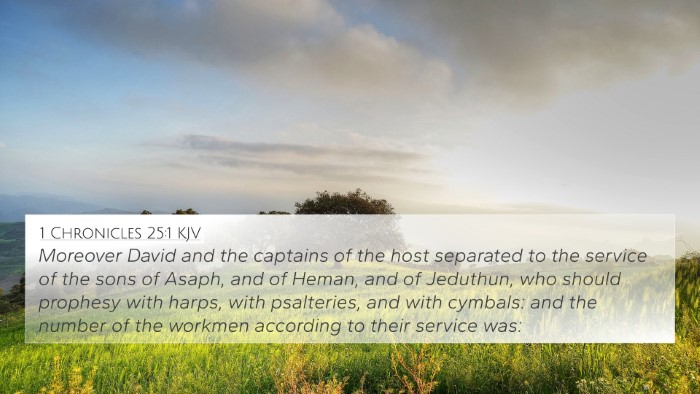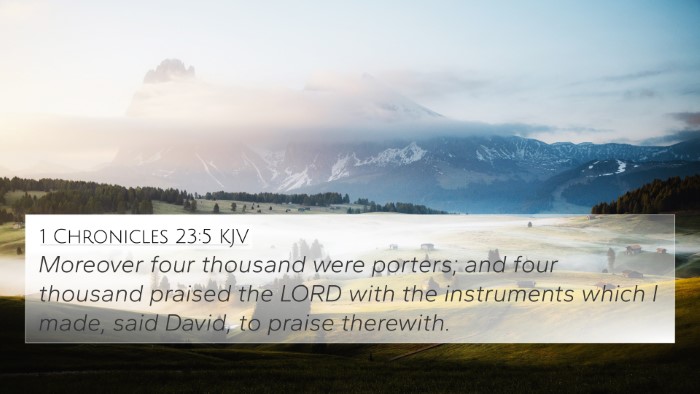Understanding 1 Kings 10:12
Overview: 1 Kings 10:12 describes the wealth of Solomon, particularly focusing on the commodities received from diverse lands. It emphasizes the grandeur of his reign and the prosperity during his rule over Israel.
Verse Text:
“And the king made of the almug trees pillars for the house of the Lord, and the king's house, harps also and psalteries for singers: there came no such almug trees, nor were seen unto this day.” (1 Kings 10:12)
Meaning and Insights:
This verse reflects the immense wealth and resources available during King Solomon's reign. The almug trees, known for their fine quality, were used in constructing significant structures for worship and royal residence. Below are interpretations from various public domain commentaries:
-
Matthew Henry:
Henry notes the significance of Solomon's decision to construct pillars and musical instruments from the almug trees, symbolizing not just wealth but the cultural and spiritual aims to honor God through music and architecture.
-
Albert Barnes:
Barnes emphasizes the rarity and value of almug wood, which was sought after for its beauty and durability. He suggests that the use of such materials reflects God’s blessing on Solomon, enabling him to create a magnificent temple and palace.
-
Adam Clarke:
Clarke discusses the types of structures that were built using the almug trees. He also highlights that the mention of musical instruments suggests a divine purpose in worship and the importance of music in religious expression.
Thematic Connections:
1 Kings 10:12 underscores themes of:
- Divine Blessing
- The Exaltation of Worship
- Joyful Expression through Music
- The Wealth of the Kingdom
Bible Cross-References:
This verse can be connected to several others, showing the interrelation of Biblical themes:
- 1 Kings 9:11-14 - Discusses the pact between Hiram and Solomon concerning supplies of timber.
- 2 Chronicles 2:8-9 - The preparations for the temple, highlighting the wood's importance.
- Psalms 92:1-3 - Illustrates the importance of music and praise in worship.
- Exodus 31:1-5 - God's appointed artisans, reminding us of the skills used in temple construction.
- Isaiah 60:13 - Prophesies the wealth and glory of Jerusalem, drawing parallels to Solomon’s reign.
- 2 Samuel 7:1-2 - David's intention to build a house for the Lord, setting the stage for Solomon.
- Revelation 21:18 - The new Jerusalem’s beauty as a reflection of divine glory, akin to Solomon’s temple.
Practical Applications:
Understanding the significance of 1 Kings 10:12 provides insight into:
- The importance of using our resources for God’s glory.
- The value of creativity and artistry in worship.
- How God blesses obedience and reverence in service.
- The historical context of worship in Israel.
Conclusion:
1 Kings 10:12 serves as a powerful reminder of how the material blessings given to Solomon were utilized for spiritual purposes. The combined insights from the commentaries reveal that the splendor of King Solomon's reign was not only marked by wealth but also by a commitment to glorifying God through the finest craftsmanship, artistic pursuits, and vibrant worship.
Final Reflection: The verse reminds believers today of the importance of using what God has entrusted to us for His glory, fostering connections with the past, and understanding the broader narrative of the Scriptures. By employing tools for Bible cross-referencing and recognizing the thematic connections between Bible verses, we deepen our appreciation for the Word of God and its relevance in our lives.







